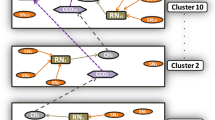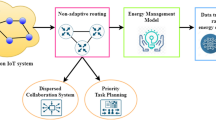Abstract
Datacollection and dissemination in wireless sensor networks (WSN) for Internet of Things (IoT) require stable multi-hop networking path from source to sink. However, due to the limited energy capacity, relay nodes that run out of battery may cause disconnected path and result in failure of end-to-end data transmission in WSN-based IoT. Therefore, besides saving energy in itself, each sensor involved in the multi-hop transmission activity also needs a feasible strategy to select the relay nodes by leveraging their residual energy and multi-hop IoT network connectivity. In this paper, we first analyze energy consumption model and data relay model in WSN-based IoT, and then propose the concept of “equivalent node” to select relay node for optimal data transmission and energy conservation. A probabilistic dissemination algorithm, called ENS_PD, is designed to choose the optimal energy strategy and prolong the lifetime of whole network. Extensive simulation and real testbed results show that our models and algorithms can minimize energy consumption while guarantee the quality of communication in WSN-based IoT in comparison with other methods.












Similar content being viewed by others
References
Olaru A, Magda Florea A, Seghrouchni A (2013) A Context-Aware Multi-Agent System as a Middleware for Ambient Intelligence. Mob Netw Appl 18(3):429–443
Deng R, Chen J, Cao X, Zhang Y, Maharjan S, Gjessing S (2013) Sensing-Performance Tradeoff in Cognitive Radio enabled Smart Grid. IEEE Trans. on Smart Grid 4(1):302–310
Chen X, Zhao Z, Zhang H (2013) Stochastic power adaptation with multiagent reinforcement learning for cognitive wireless mesh networks. IEEE Trans Mob Comput 12(11):2155–2166
Wang S, Wang Y, Coon JP, Doufexi A (2012) Energy-Efficient Spectrum Sensing and Access for Cognitive Radio Networks. IEEE Trans Veh Technol 61(2):906–912
Wu D, Bao L, Liu CH (2013) Scalable Channel Allocation and Access Scheduling for Wireless Internet-of-Things. IEEE Sensors J 13(10):3596–3604
Niu J, Cheng L, Gu Y, Shu L, Das SK (2014) R3E: Reliable Reactive Routing Enhancement for Wireless Sensor Networks. IEEE Trans Ind Inform 10(1):784–794
Atzori L, lera A, Morabito G (2010) The Internet of Things: A Survey. Comput Netw 54(15):2787–2805
Akyildiz IF, Weilian S, Sankarasubramaniam Y, Cayirci E (2002) A survey on sensor networks. IEEE Commun Mag 40:102–114
Wei Y, Heidemann J, Estrin D (2002) An energy-efficient mac protocol for wireless sensor networks. IEEE 21st conference comput commun 3:1567–1576
Chen JM, Cao XH, Cheng P, Xiao Y, Sun YX (2010) Distributed collaborative control for industrial automation with wireless sensor and actuator networks. IEEE Trans Ind Electron 57(12):4219–4230
Mao X, Tang S, Xu X, Li X, Ma H (2011) Energy-Efficient Opportunistic Routing in Wireless Sensor Networks, Parallel and Distributed Systems. IEEE Trans Parallel and Distrib Syst 22(11):1934–1942
Zhuang YY, Pan JP, Cai L (2010) Minimizing Energy Consumption with Probabilistic Distance Models in Wireless Sensor Networks. IEEE INFOCOM:1–9
Luo J, Hu J, Wu D, Li R (2015) Opportunistic routing algorithm for relay node selection in wireless sensor networks. IEEE Trans Ind Inform 11(1):112–121
Milenkovic A, Otto C, Jovanov E (2006) Wireless sensor networks for personal health monitoring: Issues and an implementation. Comput Commun 29(13-14):2521–2533
Patterson D, Fox D, Kautz H, Philipose M (2005) Fine-grained activity recognition by aggregating abstract object usage. 9th IEEE Int Symp on Wearable Comput:44–51
Gubbi J, Buyya R, Marusic S, Palaniswami M (2013) Internet of Things (IoT): A vision, architectural elements, and future directions Future Generation Comp. Syst 29(7):1645–1660
Long CN, Zhang Q, Li B (2007) Non-Cooperative Power Control for Wireless Ad hoc Networks with Repeated Games. IEEE J on Sel Areas in Commun 25(6):1101–1112
Wu D, Bao L, Li R (2010) A holistic approach to wireless sensor network routing in underground tunnel environments. Comput Commun 33(13):1566–1573
Papavassiliou S, Katsinis GK, Tsiropoulou EE (2012) Distributed Uplink Power Control in Multi-Service Wireless Networks via a Game Theoretic Approach with Convex Pricing. IEEE Trans on Parallel and Distrib Syst 23(1):61–68
Fedor S, Collier M (2007) On the problem of energy efficiency of multi-hop vs one-hop routing in Wireless Sensor Networks. 21st Int Conf Adv Inf Netw and Appl Workshops 2:380–385
Kakitani MT, Brante G, Souza RD, Munaretto A (2011) Comparing the Energy Efficiency of Single-Hop, Multi-Hop and Incremental Decode-and-Forward in Multi-Relay Wireless Sensor Networks. IEEE 22nd Int Symp Pers Indoor and Mob Radio Commun:970–974
Raghunathan V, Schurgers C, Park S (2002) Energy-Aware Wireless Microsensor Networks. IEEE Signal Proc Mag 19(2):40–50
Zalyubovskiy V, Erzin A, Astrakov S, Choo H (2009) Energy-efficient area coverage by sensors with adjustable ranges. Sensors 9(4):2446–2460
Ramaiyan V, Kumar A, Altman E (2011) Optimal Hop Distance and Power Control for a Single Cell, Dense, Ad hoc Wireless Network. IEEE Trans Mob Comput 11(11):1601–1612
Zhou Z, Zhou SL, Cui JH Cui (2008) Energy-efficiency Cooperative Communication Based on Power Control And Selective Relay in Wireless Sensor Network. IEEE Trans Wirel Commun 7(8):3066–3078
Karl H, Willig A (2005) Protocols and Architectures for Wireless Sensor Networks, Wiley. Sons Ltd, England
Goldsmith A (2005) Wireless Communications. Cambridge, England
Luo J, Pan C, Li RF, Ge F (2012) Power Control in Distributed Wireless Sensor Networks Based on Noncooperative Game Theory. International J Distrib Sensor Netw 2012:1–10
Rasti M, Sharafat AR, Seyfe B (2009) Pareto-efficient and goal-driven power control in wireless networks: a game-theoretic approach with a novel pricing scheme. IEEE/ACM Trans Netw 17(2):556–569
Zhao F, Leonidas G (2004) Wireless Sensor Networks: An Information Processing Approach. Morgan Kaufmann, San Francisco
Acknowledgments
We would thank the anonymous reviewers for their insightful comments.This work was sponsored in part by the Program for New Century Excellent Talents in University (NCET-12-0164); National Natural Science Foundation of China (61370094); Natural Science Foundation of Hunan(13JJ1014).
Author information
Authors and Affiliations
Corresponding author
Rights and permissions
About this article
Cite this article
Luo, J., Wu, D., Pan, C. et al. Optimal Energy Strategy for Node Selection and Data Relay in WSN-based IoT. Mobile Netw Appl 20, 169–180 (2015). https://doi.org/10.1007/s11036-015-0592-5
Published:
Issue Date:
DOI: https://doi.org/10.1007/s11036-015-0592-5




